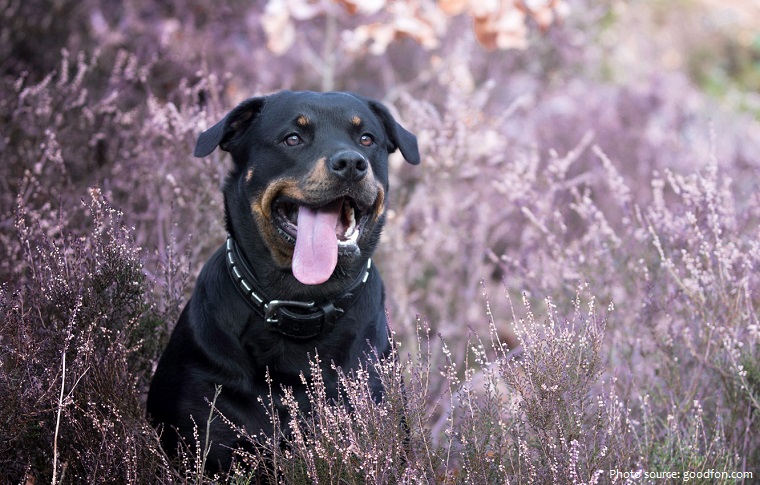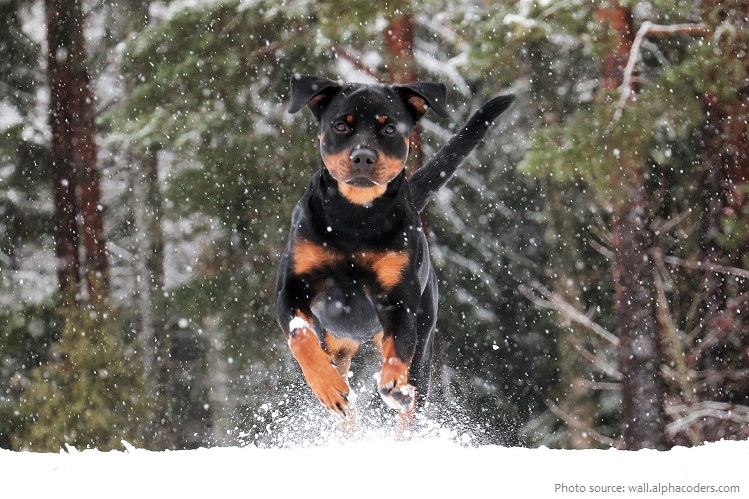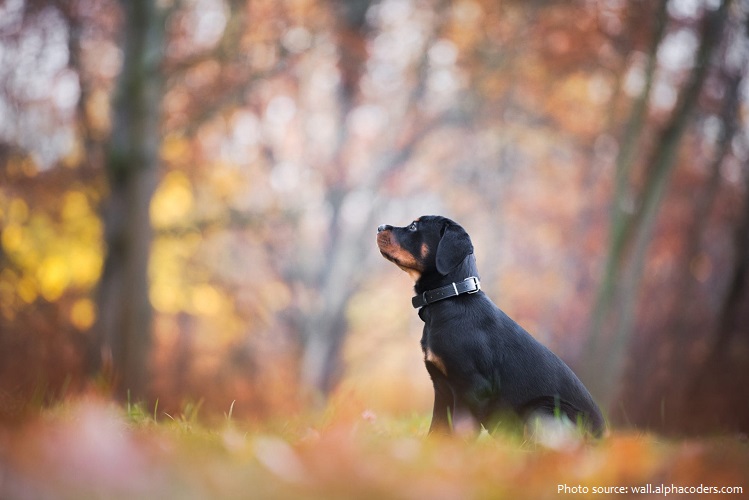
The Rottweiler is a breed of domestic dog.
Robust and powerful, the Rottweiler is happiest when given a job to perform.
His intelligence, endurance and willingness to work make him suitable as a police dog, herder, service dog, therapy dog, obedience competitor and devoted companion.
An inherent protector, the Rottweiler is self-confident and responds quietly and with a wait-and-see attitude to influences in his environment.
Characteristically stocky and strongly built, the Rottweiler stands approximately 56 to 69 cm (22 to 27 inches) tall and weighs between 35 and 60 kg (77 and 132 pounds).

It has a short, coarse, black coat with tan markings on its head, chest, and legs.
Despite that tough-looking exterior, Rotties are a sensitive breed, due to their intelligence and close attachment to their humans. So they can be prone to separation anxiety, and need an owner willing to put in the time and care they deserve.
The Rottweiler is considered to be one of the oldest dog breeds.
Its origin goes back to Roman times.
The Rottweiler’s ancestors were the drover’s dogs accompanying the herds the Romans brought with them when invading Europe.

These dogs were kept as herder or driving dogs. They marched over the Alps with the Roman legions, protecting the humans and driving their cattle.
This breed acquired its name from the old free city of Rottweil.
The town of Rottweil (from rote wil — red tile, named for fragments of red planch used for decorating Roman villas) was founded by the Romans in 73 AD, located in the south west of Germany. Hundreds of years after the fall of Rome, the dogs of Rottweil were to become known as Rottweilers.
The dogs were known in German as Rottweiler Metzgerhund, meaning Rottweil butchers’ dogs, because their main use was to herd livestock and pull carts laden with butchered meat to market. This continued until the mid-19th century when railways replaced droving.

The formal history of the breed dates back to 1901, with the production of the first standard Rottweiler by the International Club for Leonbergers and Rottweiler Dogs in Germany.
The buildup to World War I saw a great demand for police dogs, which led to a revival of interest in the Rottweiler.
During the First and Second World Wars, Rottweilers saw service in various roles, including as messenger, ambulance, draught, and guard dogs.
Although Rottweilers are not classed as herding dogs by modern kennel clubs, and despite not having been selectively bred to herd for many generations, the breed still produces puppies that can be trained to be good herders.

Rottweilers are one of the few working dog breeds eligible for field competition in livestock herding by the AKC and some other kennel clubs.
The Rottweiler’s historic role as a guardian and herder has honed the breed’s instinct for wariness and protectiveness when encountering strangers.
Rottweilers are very strong dogs, easily able to knock a full-grown and muscular man to the ground. This strength makes the dog an excellent police dog, as well as a rescue dog.

The Rottweiler needs daily physical and mental activity, either in the form of long walks or jogs, or a vigorous game in a safe area. It enjoys cold weather and may become overheated in hot weather. It can live outdoors in temperate to cool climates, as long as plenty of shelter is available. It needs
to spend significant time inside with its human family, however, so that proper bonding can occur. Coat care is minimal, consisting only of occasional brushing to remove dead hair.
They are leaners. A number of breeds, such as Great Danes and Mastiffs, enjoy leaning their big bodies up against their people. The Rottie does, too. This action is thought to originate from the breed’s need to move cattle, when they’d use their bodies to head the cows in the right direction.

According to NextDayPets, the median Rottweiler price is arond $1,000. For a Rottweiler with superior lineage, you can expect to pay anywhere from $2,500 up to $8,000 or more, depending on the breed lines.
Some countries have banned Rottweilers altogether because of fears that the breed can be dangerous, but they are still legal in the United States. Although no states in the US have a total ban on Rottweilers, some city laws are specific to Rottweilers, and not all housing communities allow residents to own the dogs.